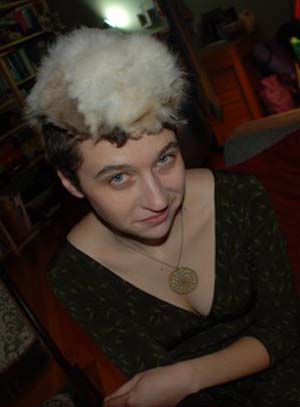The Cat IS the Hat (original) (raw)
Art Wed Sep 30 2009
 If you were at the West Loop gallery openings on Sept. 11, you may have noticed a girl walking around with a dead cat on her head. As it turns out, the girl is an artist, an MFA student at UIC, and her name is Rebecca Beachy. The cat hat is one of her new pieces. I paid her a studio visit last week, and we talked about her work.
If you were at the West Loop gallery openings on Sept. 11, you may have noticed a girl walking around with a dead cat on her head. As it turns out, the girl is an artist, an MFA student at UIC, and her name is Rebecca Beachy. The cat hat is one of her new pieces. I paid her a studio visit last week, and we talked about her work.
Kelly Reaves: Did you know that if you google "West Loop gallery openings," one of the first things that comes up is Alicia Eler's post on Chicago Now about you and your taxidermied cat hat?
Rebecca Beachy: Yeah, I saw that but I didn't know that it comes up when you google the art openings.
KR: Yep. You were at number three the first time I checked it but today you've moved up to the top. And your hat was also mentioned in an article on Art Talk Chicago about the openings. So I think it was a hit. How did you come up with the idea to make the hat?
RB: Most of my art was already concerned with material and I started thinking about the mythology of cats. I have been thinking about puns. You know, the cat in the hat. The cheshire cat. And then the LOLcat website which is such an obsession of people in our generation. So I thought it would be interesting to re-purpose the cat body to make connections between the body and the image and the mythology of the cat. The cat hat was my first project along those lines.
KR: How do you go about making a hat out of a cat?
RB: It was a gift from a UIC professor, Dan Peterman, who is an artist and ecological activist. He found it in his back alley over the winter. It was a frozen kitten. He says he knows the lineage of the feral cats that it comes from. So I took it and I did research on the internet and figured out how to skin it and tan it and form the hat. I had to change the form a little so that it would fit on the head. Part of what I like about the design is that it looks like the cat is sitting on the head. The back is what's unnerving about it because you see the tail and the legs. And that was going on right around the time that I got another cat from Carolina Biological Supply, which I've put human baby teeth on and turned into a puppet. That was a completely different way of the working with the body because it was preserved. So there's that dichotomy going on. The found cat that dies in the winter in the alley and the cat that you're not exactly sure where it came from. But they use them in science classes all over the US.
KR: Is it expensive to buy a cat?
RB: It was $40.
KR: How did you become interested in taxidermy?
RB: I have been doing work with nests and insects for a long time- natural, found materials. I was a little intimidated to work with a corpse, something larger. Although I don't think there's a very big difference. It's just that, psychologically we have a different response to a dead mammal vs. a dead wasp. I don't eat animals. I'm a vegetarian. I'm interested in the disconnect between the meat that we eat, the leather that we wear... all these ways that animal bodies are used. We're not connected to the process at all. My impetus for doing this project was to try to master that, the connection with the animal before it's shrink wrapped in the grocery store, before you buy your leather belt or your leather shoes at the mall.
KR: Are you going to make more wearable art, in addition to the kitten hat, moving into the fashion realm?
RB: I was thinking of pushing it a little further. I like the idea of absurdist fashion. Not commercialized, just deliberately over-the-top, funny fashion. I was thinking of making some squirrel slippers. There are so many ways that you can dress yourself up like an animal. What if you use the animal skin instead of the fur? I am thinking about the big, puffy Hello Kitty hats. What is it that you are identifying with about the animal? What if it was a real one, instead of a replica? It would be viewed differently, wouldn't it?

A cat marionette puppet by Rebecca Beachy
